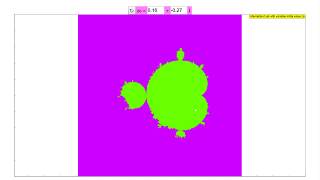About
The Mandelbrot set
The Mandelbrot set consists of points, c, in the complex plane that obey the following rule
- Start with the complex number z = a + ib where a and b are real numbers.
- Generate a new complex number, z', by multiplying z by itself and adding the result to c. z' = z2 + c.
- Repeat steps 1 and 2. If the complex number z goes toward infinity, then the starting point, c, is not a member of the Mandelbrot set. All numbers that remain bounded are members of the set.
Mandelbrot set with variable initial value
The members of the Mandelbrot set follow the rule
zn+1= zn2+ c ; initial value z0 = 0
c is a complex number, as is z
We look for points c in the complex plane, for which the series does not diverge. They form the Mandelbrot set. In the simulation they are colored red, lying within a range with the fractal boundary, the famous "apple man". Diverging points are colored green to blue, with the color shading indicating the speed of divergence.
Drawing a rectangle with the mouse defines a smaller range of calculation with correspondingly increasing resolution. Reset leads back to the initial condition.
The series has the members 0, c, c2+ c, c4 + 2c3 + c2 + c,...
For deeper understanding this simulation modifies the series in such a way, that the initial zo value is variable:
z0 = real(z0) + i * im(z0) = k + i m
This series has the members z0 , z02+c, ( z02+c)2+c, , ...
z0 = 0 (k = 0 , m = 0) delivers the common Mandelbrot set, which is the default case for the simulation.
In the drawing z0 corresponds to the white point, which can be drawn with the mouse. The fractal changes according to the change of the initial value. The values of the real and the imaginary part of z0 are shown in two editable number fields. There one can input exact values (press the ENTER key after every change).
The fractal structure is caused by the nonlinearity of the series rule. It is observed for other nonlinear series as well, with different structure of the fractal.
This simulation is part of
“Learning and Teaching Mathematics using Simulations
– Plus 2000 Examples from Physics”
ISBN 978-3-11-025005-3, Walter de Gruyter GmbH & Co. KG
Translations
| Code | Language | Translator | Run | |
|---|---|---|---|---|
 |
||||
Software Requirements
| Android | iOS | Windows | MacOS | |
| with best with | Chrome | Chrome | Chrome | Chrome |
| support full-screen? | Yes. Chrome/Opera No. Firefox/ Samsung Internet | Not yet | Yes | Yes |
| cannot work on | some mobile browser that don't understand JavaScript such as..... | cannot work on Internet Explorer 9 and below |
Credits

![]()


Dieter Roess - WEH- Foundation; Tan Wei Chiong; Loo Kang Wee; Francisco Esquembre; Wolfgang Christian; Felix J. Garcia Clemente
Sample Learning Goals
[text]
For Teachers
This is one of the multiple variations of the Mandelbrot Set simulation. There is one main difference between this Mandelbrot Set and the Julia Set simulation - that the initial z-value can be varied.
The standard Mandelbrot Set follows this algorithm: z(n+1) = z(n)^2 + c,
where z(0) is fixed at z = 0.
This simulation, however, allows the user to vary the value of z(0) by either moving the white dot on the panel or by using the field provided.
As with the other Mandelbrot Set simulations, zooming is enabled. Simply click and hold the mouse until the coordinates appear at the bottom left of the screen, and drag diagonally southeast. Give it some time to recalculate, and you get a zoomed-in version of the Mandelbrot in its full detail.
Research
[text]
Video
[text]
Version:
- http://weelookang.blogspot.sg/2016/02/vector-addition-b-c-model-with.html improved version with joseph chua's inputs
- http://weelookang.blogspot.sg/2014/10/vector-addition-model.html original simulation by lookang
Other Resources
[text]
end faq
{accordionfaq faqid=accordion4 faqclass="lightnessfaq defaulticon headerbackground headerborder contentbackground contentborder round5"}
- Details
- Written by Wei Chiong
- Parent Category: Pure Mathematics
- Category: 2 Sequences and series
- Hits: 3658








